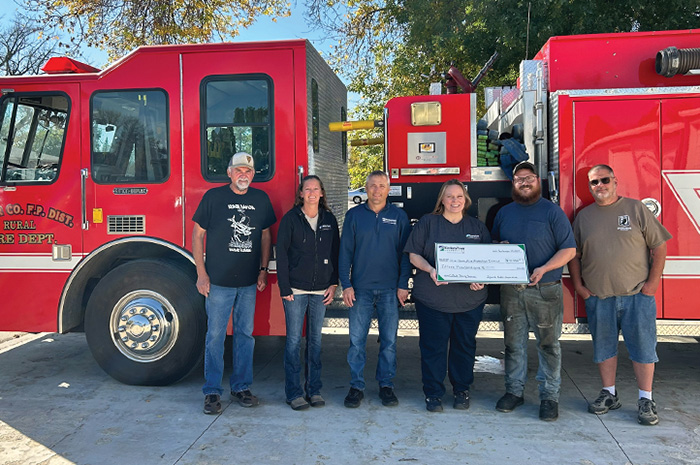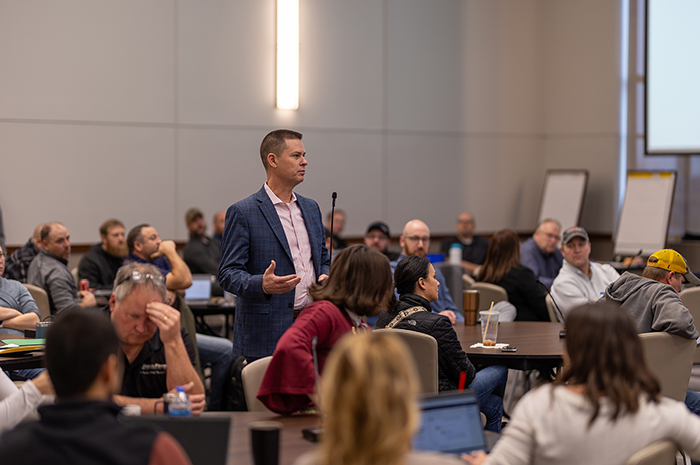Reclaiming the land
BNI Coal’s land reclamation processes continue to evolve with the changing needs of local farmers and landowners.
Jamie Mosbrucker squinted through the humidity- heavy air. He took a quick survey of the hundreds of hay bales spotting the quarter section of land under his boots. More would be baled in the days to come, making for an excellent nutritional year for the Mosbrucker cattle.
This land between Center and New Salem, N.D., has been in the family for decades, since before Mosbrucker was born.
“This area is home. It means everything to me,” he said, nodding to the horizon. “I raised my family here. I’d be the third generation, and my son, stacking bales right now, would be the fourth generation running across these particular two sections.”

The land has looked different at times. A handful of years ago, a tract of it was purchased by BNI Coal and Minnkota Power Cooperative to open a new mining area for lignite coal, used for power generation at the nearby Milton R. Young Station. Once the area was mined and the draglines moved on, the companies began the land reclamation process, which will return the land to its original productivity.
It’s a process BNI Coal has been perfecting since 1979, when land reclamation regulations solidified into what they are to this day. Mining operations like BNI are asked to salvage the top five feet of topsoil and subsoil from any area they mine and replace that soil when mining is complete. Then, BNI works with area producers to restore the land back to the quality it was before mining – as approved by the North Dakota Public Service Commission – when it can then be released back to local owners.

Mosbrucker is currently working on several areas of reclaimed farmland, producing hay, alfalfa, soybeans and other crops. He’s able to rent the land until it meets the standards for full bond release. It’s a win-win for both the lifelong farmer and BNI Coal.
“I think it’s really neat that I’ve seen the land go from what it was, before there was even mining in this immediate area, to what it is now, and to see the transformation,” Mosbrucker said. “I feel blessed that they allow us to be renting it all these years and work alongside them, because it’s a chunk of my operation.”
This land is your land
Greg Petrick, Senior Land and Public Affairs Representative for BNI Coal, works with several landowners and producers like Mosbrucker to ensure reclamation meets the standards of mining regulations. He’s focused on making sure all stakeholder voices are heard. Ultimately, it’s the long-time farmers who are the experts on how to make the land the best it can be.
“It’s a collaboration between our producers. Jamie (Mosbrucker) is a great one, because he tells us when something is wrong,” Petrick said. “We need to know what problems exist so we can try to come up with solutions and continue to learn.”

“They’re doing a job putting things back the way their plan says. And sometimes I have a different idea of how it should have been done,” Mosbrucker said with a grin. “But overall, you can’t beat the relationship. It’s been good.”
BNI’s processes have evolved as agriculture changes and the company learns more about the land. Around 10 years ago, BNI changed its practice of re-laying soil with scrapers when it learned the compaction was too high for good growth. It now spreads the soil with a truck and bulldozer, alleviating some of that compaction.
When a challenge arises, Petrick uses his network to find innovative solutions.
“We’re not afraid to try something new. We work really hand in hand – not only with producers, but with academia, too,” he said. “NDSU (North Dakota State University) has been a big supporter of ours, helping grad students so they can come out here and do research projects.”

Reclamation rules cover more than just land used for agriculture, which must be as crop productive as it was before mining. If BNI mines an area that was originally native grassland, it must ensure the same coverage and diversity of native grasses is returned to the area. With wetlands, the habitat must be ecologically similar to pre-mining conditions. Land is thoroughly analyzed and surveyed before being permitted for mining, including the collection of soil data, vegetation data, wildlife data, water data and more. That data is the measuring stick for land to meet true reclamation.
“There are regulations that we need to do this. But two of our core values at BNI are environmental stewardship of the land and community engagement,” Petrick said, adding that local landowners like Mosbrucker have become critical partners for Minnkota and BNI’s long-term energy goals. “We want to do the best for them to give them back a good return on their land and make it valuable to them again. We couldn’t do it without them.”
MAIN IMAGE: Jamie Mosbrucker stands before his latest harvest of hay from reclaimed mine land. (Minnkota/Michael Hoeft)
...



